Scientific Facts
| Common Name | Red Crossbill |
| Scientific Name | Loxia curvirostra |
| Lifespan | 8 Years |
| Size | 14 – 20 cm. |
| Mass | 23.7 – 45.4 grams |
| Habitat | Temperate, terrestrial forests |
| Origin/ Range | Northern hemisphere |
Information & Physical Description

Scientifically referred to as Loxia curvirostra, the red crossbill is also known as a common crossbill in Eurasia. This small bird belongs to the order Passeriformes and is classified in the finch family Fringillidae.
Red crossbills are described as finches of medium size. Males are only a bit bigger in size than the females, as they typically attain between 23.8 and up to 45.4 grams of body mass, while females attain a body mass of 23.7 and up to 42.7 grams.
The most distinct characteristic of red crossbills are the mandibles that are crossed at the very tips; red crossbills are capable of extracting seeds from various fruit, as well as from conifer cones.
Adult male common crossbills are usually brightly colored in hues of orange-reddish-yellow or deep red. The flight and tail feathers are dark brown in colors.
The females’ breasts and rumps are typically colored in greenish-yellow or olive to gray nuances. As with males, the flight and tail feathers are dark brown.
Immature red crossbills’ body coloration’s background is lighter as opposed to the overall brown streaking, while their tails are notched.
Unlike other bird species, common crossbills’ plumage does not undergo any seasonal changes.
However, as there are many variations in red crossbills’ call types, coloration, and nonetheless, the shape and size of their beaks, the diverse variants of these extraordinary birds often belong to different classifications, and some of them have been actually named as subspecies of the common crossbill.
In general, all crossbills live up true to their English name as they are characterized by the mandibles being distinctly crossed at the tips. By making perfect use of their crossed mandibles, crossbills can leverage by excellently separating conifer cones’ scales for the purpose of extracting the seeds they wish to feed on.
When it comes to the different variants of red crossbills, there are about nine distinct variants in North America, commonly referred to as call types, since they differ in beak shape and size, as well as in vocalizations. Also, each of these cell types has evolved in specializing in feeding on different conifer species.
Interestingly, there has been a debate on whether or not the different call types should be actually considered separate species.
For instance, the crossbill variant occurring in Idaho’s Albion Mountains and in the South Hills, aka the South Hills crossbill, has been classified as a new species that is scientifically referred to as Loxia sinesciuris. The reason for describing it as a separate species is related to the fact that the South Hills crossbill has been observed to show a rather low degree of hybridization with the common crossbill.
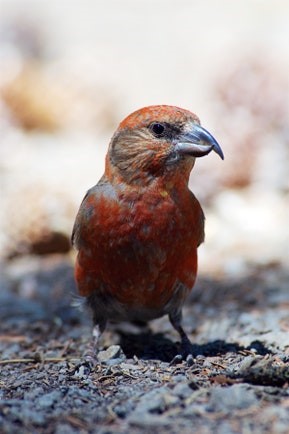
South Hills crossbill – Image Source
Currently, several pine-feeding, large-billed populations are assigned as red crossbill species, although experts confirm that more research is needed in order to properly classify these amazing bird species, which include the Balearic crossbill (scientifically referred to as L. curvirostra balearica), as well as the North African crossbill (L. curvirostra poliogyna). Both of these species are known to feed primarily on Pinus halepensis (aka Aleppo pine).
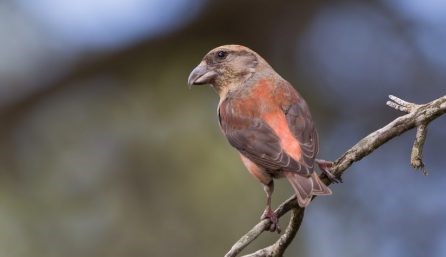
Balearic crossbill – Image Source
Other variants of the red crossbill that may be possibly reclassified as separate species in the future include the Cyprus crossbill (L. curvirostra guillemardi), known to feed mainly on Pinus nigra (European black pine).

Common crossbill at Mount Olympus, Cyprus, Greece (Cyprus crossbill) – Image Source
Ultimately, the populations of North African, Cyprus and Balearic crossbills also differ in plumage as the males in these races are yellower, while the Balkan type male races are known to have more members colored in deep pink-purple pink, although the purple-pink coloration may be due to the high content of anthocyanin present in the cones these birds feed on, since anthocyanin pigments are transferred to their feathers.
According to researchers, the Palearctic populations of red crossbills have been observed to show similar levels of variation as those in North America, as well as a similarly tight association of call types.
Quintessentially, red crossbills are easy to distinguish from other bird species thanks to their unique crossed bills, yet it can be quite difficult to distinguish them from other closely related species in the genus Loxia.
One particular member of the genus Loxia, namely Loxia leucoptera, (aka the white-winged crossbill), is easy to distinguish by the wing bars that are colored in white.
The red crossbill is particularly difficult to distinguish from the Scottish crossbill and the parrot crossbill. Both the Scottish and the parrot crossbill are known to breed within the Eurasian range of the red crossbill, further making the plumage distinctions between these species quite negligible.

Scottish crossbill – Image Source
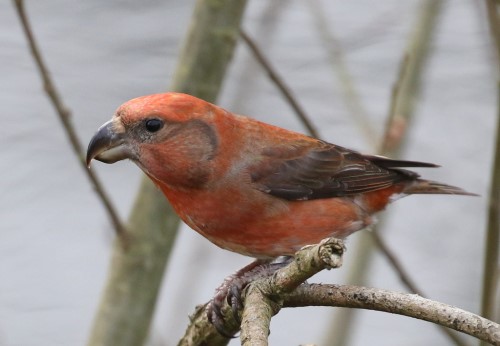
Parrot crossbill – Image Source
The best indicator to help bird watch enthusiasts distinguish the Scottish and parrot crossbill is the glip or chup.
Lifespan
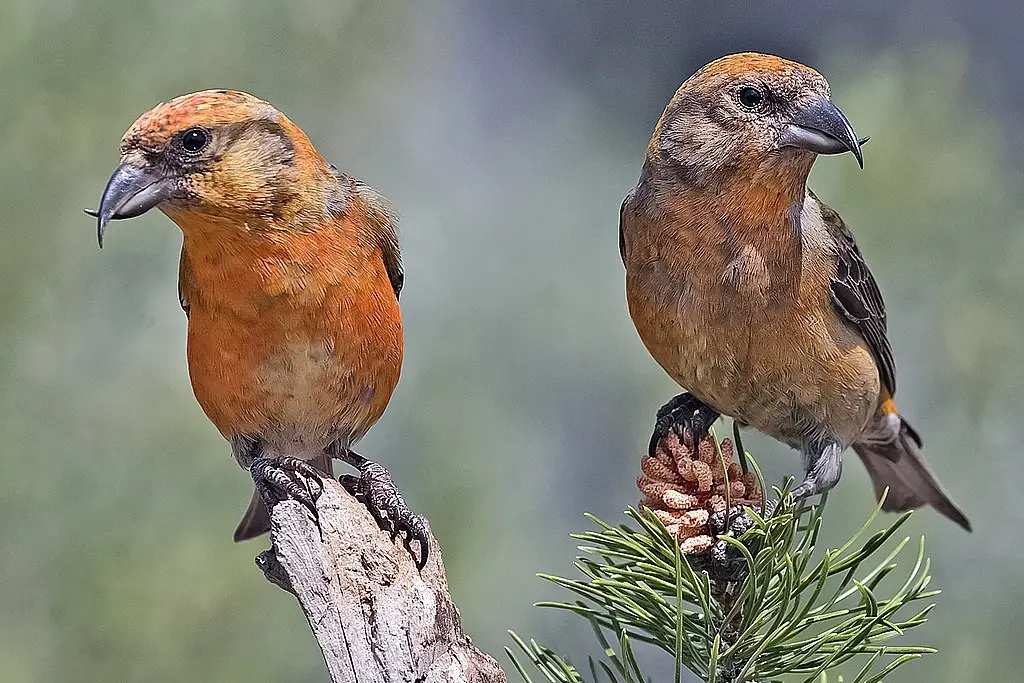
According to the Animal Ageing and Longevity Database, red crossbills may live up to 16 years in the wild.
However, the average lifespan of these birds is estimated at about 8 years, based on the still limited evidence on the oldest recorded red crossbill in the world up-to-date being one male of at least 8 years of age that was recaptured and then successfully re-released during ongoing banding operations taking place in Idaho at the time.
Ecosystem & Habitat
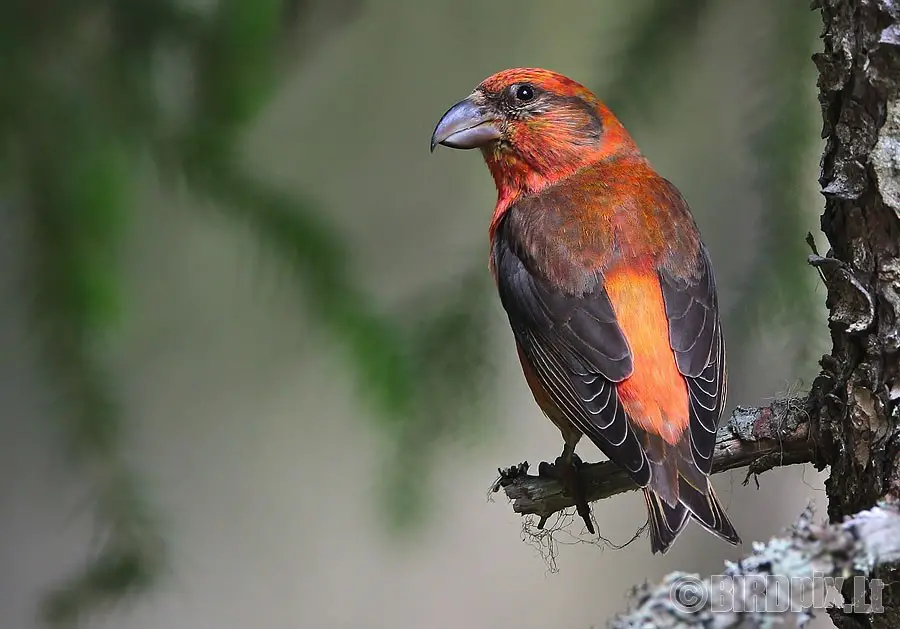
Red crossbills are not migratory birds; however, it is during the breeding season when these birds do wander widely outside of their natural range in the northern hemisphere.
Interestingly, during occasional irruptions, thousands of red crossbills are involved in traveling outside their normal range.
In America, red crossbills are known to occupy high altitude coniferous forests and northern arboreal, spanning across much of Canada and all the way to maritime provinces, to coastal Alaska, northern Michigan, Wisconsin, Minnesota, New Hampshire, Maine, Vermont, and New York.
Also, these birds are found in their desirable type of habitats throughout the Sierra Madre, Rocky Mountain, and Sierra mountain range. Nonetheless, they are found in smaller mountain ranges, such as in the Mexican volcanic belt, Honduras, Belize, Baja California, and Nicaragua.
Although small in number, distinct, disjoined crossbill breeding populations are recorded in the Appalachian Mountains. Outside their normal range, breeding populations are also found occasionally.
In the Palearctic, red crossbills’ range extends from Asia to Japan and the Kamchatka Peninsula, in Russia, as well as across northern Europe to the British Isles, and nonetheless, inappropriate habitats in Vietnam, the Philippines, The Alps, Himalayas, Pyrenees, and northern Africa’s Atlas Mountains.
In Scotland, red crossbills co-occur with other similar species, namely the Scottish crossbill (Loxia scotia), while in western Russia and Scandinavia, they co-occur with the Loxia pytyopsittacus species (parrot crossbills).
Red crossbills are usually almost exclusively found in coniferous woodlands consisting of mature spruce (Picea), pine (Pinus), fir (Abies), and hemlock (Tsuga) forests. Provided ample supplies of conifer seeds to feed on are available, red crossbills can also be found in mixed forests consisting of deciduous and coniferous trees.
The specific “call types” of red crossbills are related with specific conifer species, for instance, in western America two specific types of red crossbills characterized by large bills, are considered closely associated with the cones of Pinus ponderosa (ponderosa pine), Picea engelmanni (Engelmann’s spruce), and Pinus pungens (table mountain pine).
Meanwhile, the eastern type of red crossbill is majorly associated with Picea mariana (Newfoundland black spruce). On the other hand, variants of red crossbills characterized by small bills are related to smaller cones conifers, like the Pseudotsuga (Douglas-fir) and Tsuga (hemlock) cones.
It is exactly because of the close association between conifer species and red crossbills’ call types why the description of many subspecies has occurred. Furthermore, there has been much speculation regarding the food types’ selection based on bill shape, and the ensuing reproductive isolation through vocalizations, even though extensive mitochondrial DNA studies did not show any evidence of reproductive isolation existing among call types or subspecies.
Instead, experts believe that the rapid local adaptations are the actual result of the morphological differences among red crossbills’ populations that have specialized to feed on specific species of conifer.
Fundamentally, the key role played by red crossbills as part of the intricate ecosystems on the planet is one of being extremely important conifer seed predators throughout their range. Regional populations of the common crossbill have strongly specialized in the extraction of the seeds of very particular species of conifer.
Food & Diet

Feeding exclusively on conifer seeds, common crossbills’ populations (or call types as these are commonly referred to as), are believed to have specialized bill morphologies, making them brilliant at taking out and feeding on the seeds located in the cones of very specific conifer species.
In order for individuals to take the utmost advantage of the conifer seed crops available locally, red crossbills are known to travel together in feeding flocks. It is believed that by traveling together in feeding flocks (also known as flocking), red crossbills succeed in assessing the most suitable foraging areas, while also simultaneously managing to avoid predation.
It is red crossbills’ calling rates and calls that transmit extremely important information regarding food availability, and so when foraging birds start calling, flying birds can join the foraging flocks.
It is important to note, though, that the call rate among foraging birds has been found to increase as the birds are to spend more time engaged in foraging, presumably getting to have less access to available food.
When the red crossbills’ call rates are to reach a gradual increase in loudness (crescendo), the flock is to depart in search of other foraging opportunities.
Curiously, consistent with their unique specialization on different species of conifers, the calls of foraging red crossbills do not attract flying groups of other call types.
Red crossbills are capable of holding unattached cones in their feet successfully enough to feed on these; however, they are known to feed predominantly on conifer cones that are still attached to the tree instead.
Using their extraordinary, peculiar mandibles, red crossbills bite right between the cone scales. While they bite, the lower mandible is to open the conifer’s scale, thus, successfully exposing the conifer seed itself.
When it comes to dealing with cones that are tougher than the average to get their seeds extracted, red crossbills will bite several times, and/or they will also have to twist their heads before finally using their tongue to reach the seed.
Thanks to their amazing “crossed” mandibles, red crossbills are capable of exploiting a food niche that no other seed-eating bird on the planet is capable of exploiting.
As soon as the red crossbill is to expose the conifer seed, the bird is to remove the seed coat by using its tongue, as well as its mandible. Small seeds are swallowed whole, while larger seeds are crushed by the bird before being swallowed.
To help process their seed diet successfully, red crossbills are known to take sand or grit into their crops, too.
Reproduction

Loxia curvirostra bird species are monogamous. According to observations, they appear to stay together in pairs all throughout the year. However, there is an absence of evidence on whether year-round pairs are to also mate during the breeding season.
To attract the attention of females, male red crossbills are to sing from perches and to make display fights. In fact, during the breeding season, males are to act aggressively towards other males.
Courtship among Loxia curvirostra species includes the male feeding the females, as well as both grabbing each other by the bills (aka billing).
After courtship, males are to constantly accompany females while the period of egg-laying lasts, and this is believed to possibly prevent any extra-pair copulations.
Interestingly, many aspects of red crossbills’ breeding are highly influenced by food availability, much like the case with these birds’ behavior in general.
Although local populations breed seasonally, it is not an exception for red crossbills to breed almost every single month throughout their natural range. Given enough conifer seeds to feed on, red crossbills may breed for a total of up to nine months throughout the year.
In North America, Loxia curvirostra eggs have been recorded from December to September.
It is the mated pairs’ duty to select an appropriate nest site. Typically, the selected nest site is a densely covered interior conifer tree branch located from two and up to twenty meters above the surface of the ground.
Even though females are the ones to build the nest, males do also contribute to the nest building process by bringing nesting materials.
Nests are made out of conifer twigs, and the twigs are further lines with conifer seeds, lichen, grasses, feathers, and shredded bark.
Female red crossbills usually lay 3 eggs, with 1 egg being laid per day. The incubation begins once the last egg has been successfully laid, although incubation may also be delayed if the weather is too cold.
Eggs need to be incubated by the females for a period of 12 to 16 days. For the first five days after hatching, they usually brood continuously. During brief absences of their mothers, hatchlings go into lethargy.
Due to lack of food and/or cold weather, hatchling, as well as fledging, maybe sometimes delayed.
It is within 15 and up to 25 days after hatching that the young are to fledge, and then again, the exact timing of fledging depends on food availability.
Once they fledge, the young Loxia curvirostra will follow both of their parents around, continuing to beg for food while they practice the art of obtaining conifer seeds. However, if the female is to lay a second clutch, the young will only follow the male parent.
It is not uncommon for parents to keep feeding their young for up to 33 days after fledging.
Young red crossbills are capable of becoming sexually mature as early as within 100 days after hatching, even before they have managed to take on their adult plumage.
It is in an altricial state how young Loxia curvirostra hatch, so they rely heavily on their parents sharing parental duties to help them survive.
Females are in charge of incubating and brooding the young, while males are in charge of defending small foraging-friendly territories. Also, males do further provide some courtship food for the mothers, and they do keep feeding hatchlings and fledglings alike up until the point when the young become masters at extracting the vital conifer seeds from the cone.
Behavior

Red crossbills are flocking birds that do not migrate, yet they do range widely, searching for good sources of conifer seeds outside their breeding season. These birds are extremely social and active.
Being well-adapted to cold winter weather lows, these birds are believed to wander in response to the availability of cone crop, and that’s why red crossbill populations’ mass movements are most likely to occur during the autumn season, as this is when the conifer cones are to ripen, offering crossbills the opportunity for a fantastic food feast.
Red crossbills’ mass movements can, at times, involved thousands of birds flocking together, ultimately resulting in these birds invading new regions.
Being fast and strong fliers, red crossbills are not believed to be territorial, and neither are there any strictly confirmed home ranges of these birds.
These largely nomadic birds have only been reported to possibly defend a relatively small territory during the breeding season; however, more research is still needed so that this bit of information can be fully confirmed.
Being divided into a discrete type of category known as “call types,” based on their bill morphologies allowing them to specialize in the extraction of specific seeds of specific conifer species, red crossbills continue to puzzle researchers trying to identify and classify their behavior and types into suitable categories.
Immature common crossbills of virtually all call types do make quite similar sounds during their nestling, as well as the fledging stage. However, as they reach independence and turn into adults, they begin to use the specific call type they have inherited from their parents.
To remain in contact with each other, mated pairs have been found to mimic each other’s calls in order to produce a quite identical flight call. Red crossbills’ flight calls are described as a chip-chip-chip sound. Male red crossbills’ songs sang from the perches located near their nest, are said to resemble a buzzing zzzt-zzzt or whit-whit sound, yet these songs do vary among different call types.
Other vocalizations used by the common crossbills are based on the current condition, behavior, and/or “mood” of the bird, including courtship calls, excitement calls, chitter calls, threat calls, and distress/alarm calls.
How to Attract Red Crossbills
It is based on the landscape, geography, and climate in your area of residence when it comes to what type of different backyard bird species may choose to visit you, including but not limited to red crossbills.
During the cold winter months, birdfeeders can attract a whole array of amazing feathery companions, and if you happen to live in the northern regions of the world, then you should definitely consider using an enticing feeder to attract red crossbills, pine grosbeaks, and evening grosbeaks, among others.
1. During the winter, a bird feeder must be made as useful as possible as to be able to attract birds to your backyard. The feeder should be best equipped with a wide cover located over the feeding perches and ports. Also, dispensing trays will help to prevent seeds from getting buried below the snow during storms and/or heavy snowfalls.
2. Consider the fly-through type of platform feeders, since this design is especially welcome to attracting birds for winter feeding in your backyard. The feeder’s cover should extend over the feeder’s edges with several inches. Apart from feeders with built-in covers, you can make perfect use of adding wide baffles to keep ice and snow at bay.
3. If possible, place the bird feeder in a sheltered location where the feeder will be kept away from the most severe winter winds. It is best to place the feeder close to your house so that the feeder will not only be effectively sheltered but so that you can have the perfect indoor bird-watching spot.
4. To offer birds some protection from predators, consider placing the feeder near a brush pile, hedges, or other suitable protective covers nearby.
5. In order to keep window collisions to the bare minimum, it is best to place the feeder at no more than 5 feet away from a window or wall. To further help birds avoid the glass, you can utilize window clings, among other suitable techniques.
6. Keep in mind that large-capacity feeders are strongly recommended for winter bird feeding. That’s because you won’t really need to constantly refill large-capacity feeders. However, do note that this may or may not work well since if the seed is not protected from moisture, it will inevitably grow fungus or mold before being consumed, and hence, you will need to frequently replace it anyway.
7. One of the best type of feeders to attract red crossbills among other birds in the winter season are large-capacity covered feeders. If frequent refilling of the feeder is not an issue to you, then open platform type of feeders can work great, as long as they are emptied and then refilled daily to prevent seed spoilage.
8. Do note that with the scarce availability of natural food sources in the winter, bird feeders tend to attract a huge number of birds (definitely not solely red crossbills), and because of this, the feeders require regular cleaning and sterilization. By properly cleaning the feeder, you will be able to minimize unhealthy feeding conditions that can foster various unwanted diseases, which can be spread among bird populations visiting your backyard to feed.
9. To clean a birdfeeder properly, discard any seed encases in ice, as well as soggy seed. Next, allow the feeder to dry completely before refilling it. Wipe down all parts of the feeder, including poles and perches.
10. The best type of seeds to attract red crossbills, among other birds within the northern hemisphere, include beef suet, oil-type sunflower seed (black oil sunflower seed), and Nyjer (thistle) seed.
11. It is a great idea to stock up on birdseed in mid- to late fall, as this is when many garden centers make awesome discounts.
12. Make sure to store seeds properly, away from excess heat, in a dry and cool place, well-protected from possible rodents or bugs attacks.
13. Remember that since food is scarce in the winter for birds, this is exactly the case with various backyard predators and pests.
Because of this, consider providing birds the much-needed security if you want to get them continuously return to the feeder.
For this purpose, you can opt for specialized feeders that include squirrel baffles or caged perches.
Also, metal, as well as thick plastic feeders, will resist possible chewing best.
You can position feeders close to a natural cover where birds can hide if the need is to arise; however, do not place the feeders too close to the natural cover to allow predators to patiently hide in ambush.
To keep pest wildlife and/or predators at bay, you can take advantage of a mesh or temporary fencing placed around the feeder.
14. Last but not least, you can add a heated birdbath in order to provide birds with an attractive source of crops. Alternatively, you can make use of a safe heating element attached to a regular birdbath.
15. Finally, watch for the red crossbills attend your backyard feeder and/or birdbath, and don’t hesitate to take pictures or videos of these extraordinary feathery visitors to share with friends and family!
Possible Health Issues
Red crossbills are parasitized by biting lice (Mallophaga). These lice are known to feed on skin, feather, and blood.
While bird lice do not typically cause much harm to the red crossbill, or to other birds that are commonly attacked by many different kinds of bird lice, it might be the case that these lice will manage to unusually infest a particular area of the bird’s body, such as the bill. If the bill is heavily infested, the bird will not be able to preen itself properly.
Also, in severe cases, irritation may lead to the bird to damaging itself by excess scratching.
In case you come across an injured and/or visibly sick red crossbill, please, immediately contact wildlife rescue. Do not attempt to treat the bird by yourself as this may not be only harmful to the animal but may be harmful to your own health, as well.
Availability – Where to Get a Red Crossbill

Nowadays, it is possible to come across online vendors offering crossbills for sale. While it is not legal to keep wild birds as pets in general, in some areas across the globe, it is legal to purchase a crossbill that has been Aviary bred and close rung.
However, not all bird care enthusiasts support such captive raising practices, and many will only purchase a crossbill to enjoy getting it released into its natural range in the wild.
It is best to admire these birds in the wild. When on a hike in coniferous forests within the natural range of red crossbills, look around for these astonishing birds, and most importantly, listen for them.
Red crossbills’ call notes are described as metallic and sharp. The birds will typically occur in flocks that will chatter nearby the very tops of the trees.
It is in the morning when red crossbills will frequently come down to the ground in order to consume the much-needed addition to their diet, and in particular, grit, commonly located along roadsides.
As red crossbills are nomadic, they will sometimes irrupt far south of their usual range in some years. At such times, these birds may show not only in planted evergreens or in evergreen forests, but also at bird feeders.
Cool Facts

1. The scientific name for red crossbill – Loxia curvirostra –originates from the Ancient Greek word “loxos” which translated into “crosswise,” and the Latin word “curvirostra,” meaning “curved bill.”
2. The Red Crossbill is extremely dependent on conifer seeds. Even the young red crossbills are fed with conifer seeds. In fact, these birds can choose to breed virtually at any time, as long as they manage to find a sufficient cone crop, even if this is to happen in the coldest winter months.
3. It is thanks to the oddly shaped bill how red crossbills manage to take grip into even the most tightly closed cones. These birds’ biting muscles are much stronger than the muscles in charge of opening the bill. And so, the red crossbill simply places the very tips of its slightly open bill right under the scale of a cone, and then bites down, thus, pushing the scale-up using the bill’s crossed tip, and finally, exposing the delicious seed hidden inside.
4. As compared with the basal metabolic rates of red crossbills in the wild, those monitored in captivity have been discovered to exhibit 19% higher basal metabolic rates than the average rates for the particular bird’s body size.
5. Red crossbills are a fascinating example of birds that make an integral, and nonetheless, especially interesting part of the coniferous habitats they thrive in. Moreover, these birds’ example is one of extreme specialization to a particular type of food, related to rapidly resulting adaptations in morphology.
6. According to an ancient European legend, red crossbills were said to have shaped their curious, unique bills when the birds were trying to remove the nails from the hands and feet of Jesus Christ while He was on the cross.
7. One of the great mysteries of the classification of red crossbills that keeps puzzling experts up-to-date is where exactly should they draw the line between the different species.
The thing is, many variants of the red crossbill that have been described up-to-date do simply not conform very well to the regular concepts regarding the categories known as “species” and “subspecies.”
Contrary to many subspecies, the different variants of red crossbills are highly nomadic, as they wander widely, and sometimes join up with flocks consisting of other types of crossbills!
However, even when they do so, interbreeding between the different types has been estimated as very limited, further suggesting that what we nowadays consider as types of the red crossbill may actually become full species at some point in the future when more of the much-needed extensive research is available for evaluation.
How to Care for the Red Crossbill

The best way to take care of the red crossbill is to acknowledge the unique role these birds play as an intricate part of the ecosystems on planet Earth.
Due to climate change, accompanied and further triggered by deforestation, mass extinction of animal species, plastic pollution, wildfires, and other natural disasters increasingly taking place on a global scale, it is our collective responsibility to take the best care of the unique species of animals inhabiting the world alongside us, human beings.
Spreading awareness over the dire need of protecting wildlife and embracing environmental-friendly practices is, undoubtedly, the smartest way to take proper care for the populations of red crossbills across the globe.
Not the least, if you happen to live in an area where red crossbills may occur during the winter, do not hesitate to add birdfeeders to your backyard, as to supply these feathery friends with a fresh source of food while you are blessed to enjoy their company to the fullest.
FAQs
What Does a Red Crossbill Look like?
Adult male red crossbills are usually overall brick red, with their tails and wings being darker in color. Adult female red crossbills are typically mostly olive-brown or brown on the above and yellowish below, while immature red crossbills are pale below, as well as with brownish streaking below vs. brownish coloration above.
Where Do Crossbill Birds Live?
Red Crossbills are known to inhabit conifer forests consisting of mature trees; however, the different types of red crossbills can specialize in feeding on particularly preferred trees, such as Engleman spruce, Lodgepole pine, western hemlock, Sitka, and Ponderosa pine. These birds live in the northern hemisphere, but irruptions in some years may lead red crossbills far south from their natural range in search of food.
What Do Red Crossbills Eat?
Red crossbills eat predominantly conifer seeds. Sometimes, they may come to bird feeders for seeds, too, and occasionally, they may also eat other seeds, berries, and insects. They also eat small amounts of grit/sand to help with the proper digestion of seeds.
What Does the Common Crossbill Use its Beak for?
Crossbills use their oddly-shaped, peculiar beaks for the purpose of tearing the scales of pine cones apart so that they can reach the seed inside. After the scales are parted successfully, crossbills are to use their strong tongues to first detach and then grab the delicious seed.
Are Red Crossbills Endangered?
No, red crossbills are not endangered, as their populations are estimated as stable, and hence, the conservation status of these bird species is Least Concern. Even though two-barred crossbills are also listed as Least Concern, their populations have decreased in recent years.


